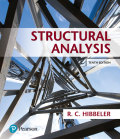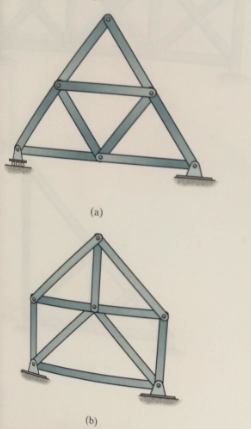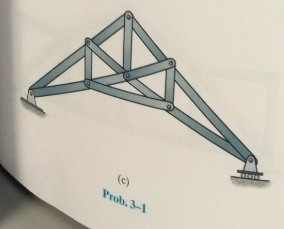
Classify each of the following trusses as statically determinate, statically indeterminate, or unstable. If indeterminate, state its degree.


(a)
If, the truss is statically determinate, statically indeterminate or unstable and its degree.
Answer to Problem 3.1P
The truss is statically determinate.
Explanation of Solution
Given:
One end of the truss has roller support and the other end has pinned support.
Concept Used:
The determinacy of the structure is obtained from the formula:
If
If
If
Where j is the number of joints.
m is the number of members of the truss.
r is the number of reactions at the support.
In case of pinned support there are two reactions.
In case of roller support there is only one reaction.
In case of fixed support there are three reactions.
In case of simple support there is only one reaction.
Calculation:
Here,
Which implies that the truss is statically determinate.
Conclusion:
Hence, the truss is statically determinate.
(b)
If, the truss is statically determinate, statically indeterminate or unstable and its degree if indeterminate.
Answer to Problem 3.1P
The truss is statically indeterminate.
Degree of indeterminacy i=2.
Explanation of Solution
Given:
Both the ends of the truss have pinned joint.
Concept Used:
The determinacy of the structure is obtained from the formula:
If
If
If
Where j is the number of joints.
m is the number of members of the truss.
r is the number of reactions at the support.
In case of pinned support there are two reactions.
In case of roller support there is only one reaction.
In case of fixed support there are three reactions.
In case of simple support there is only one reaction.
Calculation:
Here,
Which implies that the truss is statically indeterminate with degree of indeterminacy as 2.
Conclusion:
Truss is statically indeterminate.
Degree of indeterminacy i=2.
(c)
If, the truss is statically determinate, statically indeterminate or unstable. If statically indeterminate and its degree.
Answer to Problem 3.1P
The truss is statically determinate.
Explanation of Solution
Given:
One end of the truss has pinned support and the other end has roller support.
Concept Used:
The determinacy of the structure is obtained from the formula:
If
If
If
Where j is the number of joints
m is the number of members of the truss
r is the number of reactions at the support
In case of pinned support there are two reactions
In case of roller support there is only one reaction
In case of fixed support there are three reactions
In case of simple support there is only one reaction
Calculation:
Here,
Which implies that the truss is statically determinate.
Conclusion:
Truss is statically determinate.
Want to see more full solutions like this?
Chapter 3 Solutions
EBK STRUCTURAL ANALYSIS
Additional Engineering Textbook Solutions
Starting Out with C++: Early Objects (9th Edition)
Starting Out with Java: From Control Structures through Data Structures (4th Edition) (What's New in Computer Science)
Computer Science: An Overview (13th Edition) (What's New in Computer Science)
Database Concepts (8th Edition)
SURVEY OF OPERATING SYSTEMS
Introduction To Programming Using Visual Basic (11th Edition)
- A steel rod 100 ft long holds a 200 lb weight as shown. If the diameter of the circular rod is ¼ inch, find the maximum normal stress in the road, taking into account the weight of the rod itself. Use: density of steel = ϒ = 490 lb/ft3 .arrow_forwardضهقعفكضكشتبتلتيزذظظؤوروىووؤءظكصحبت٢٨٩٤٨٤ع٣خ٩@@@#&#)@)arrow_forwardضهقعفكضكشتبتلتيزذظظؤوروىووؤءظكصحبت٢٨٩٤٨٤ع٣خ٩@@@#&#)@)arrow_forward
- A square flexible foundation of width B applies a uniform pressure go to the underlying ground. (a) Determine the vertical stress increase at a depth of 0.5B below the center using Aσ beneath the corner of a uniform rectangular load given by Aσ Variation of Influence Value I m n 0.5 0.6 0.8 1.0 0.2 0.4 0.2 0.01790 0.03280 0.03866 0.04348 0.05042 0.05471 0.4 0.03280 0.06024 0.07111 0.08009 0.09314 0.10129 0.5 0.03866 0.07111 0.08403 0.09473 0.11035 0.12018 0.6 0.04348 0.08009 0.09473 0.10688 0.12474 0.13605 0.8 0.05042 0.09314 0.11035 0.12474 0.14607 0.15978 1.0 0.05471 0.10129 0.12018 0.13605 0.15978 0.17522 (Enter your answer to three significant figures.) Ασ/90 = Activity Frame (b) Determine the vertical stress increase at a depth of 0.5B below the center using the 2 : 1 method equation below. 90 x B x L Aσ = (B+ z) (L+ z) (Enter your answer to three significant figures.) Δσ/90 = (c) Determine the vertical stress increase at a depth of 0.5B below the center using stress isobars in…arrow_forwardNeed help!!!arrow_forward2 A flexible circular area is subjected to a uniformly distributed load of 450 kN/m² (the figure below). The diameter of the load area is 2 m. Estimate the average stress increase (Aσay) below the center of the loaded area between depths of 3 m and 6 m. H₂ 1.0 H₂ B 0.8 CHI HD DV 0.6 C 1.0 1.5 0.4 0.2 6.0 8.0. 10.0 2.0 2.5 3.0 4.0 5.0 H₁ (Enter your answer to two significant figures.) Δσαν τ kN/m² 6arrow_forward
- Refer to the figure below. Using the procedure outlined in your textbook, determine the average stress increase in the clay layer below the center of the foundation due to the net foundation load of 45 tons. Use the equations: Aσ = and qo x B x L (B+ z)(L+ z) Aσ av (H2/H₁) Δσι +44 + Δσο net load 6 4:5 ft 10 ft 5ft x 5ft Sand Sand y=100 lb/ft³ Ysat 122 lb/ft³:" Ysat 120 lb/ft³: 0.7 C=0.25 Groundwater table C=0.06 Preconsolidation pressure = 2000 lb/ft² (Enter your answer to three significant figures.) Ασαν = lb/ft²arrow_forwardRefer to the figure below, which shows a flexible rectangular area. Given: B₁ = 4 ft, B₂ = 6 ft, L₁ = 8 ft, and L2 = 10 ft. If the area is subjected to a uniform load of 4100 lb/ft², determine the stress increase at a depth of 10 ft located immediately below point O. Use the table below. T B(1) 3 B(2) 2 L(1) * 4 L2) Table 1 Variation of Influence Value I n m 0.8 0.9 1.0 1.2 1.4 0.1 0.02576 0.02698 0.02794 0.02926 0.03007 0.2 0.05042 0.05283 0.05471 0.05733 0.05894 0.3 0.07308 0.07661 0.07938 0.08323 0.08561 0.4 0.09314 0.09770 0.10129 0.10631 0.10941 0.5 0.11035 0.11584 0.12018 0.12626 0.13003 0.6 0.12474 0.13105 0.13605 0.14309 0.14749 0.7 0.13653 0.14356 0.14914 0.15703 0.16199 0.8 0.14607 0.15371 0.15978 0.16843 0.17389 0.9 0.15371 0.16185 0.16835 0.1766 0.18357 1.0 0.15978 0.16835 0.17522 0.18508 0.19139 1.1 0.16843 0.17766 0.18508 0.19584 0.20278 (Enter your answer to three significant figures.) Aσ = lb/ft²arrow_forwardPoint loads of magnitude 100, 200, and 380 kN act at B, C, and D, respectively (in the figure below). Determine the increase in vertical stress at a depth of 6 m below point A. Use Boussinesq's equation. B 6 m A 6 m с 3 m D (Enter your answer to three significant figures.) Δαχτ kN/m²arrow_forward
- Two line loads q₁ = 30 kN/m and 92 = 44 kN/m of infinite lengths are acting on top of an elastic medium, as shown in the figure below. Find the vertical stress increase at A. 92 91 6 m 3 m 3 m Δσ A (Enter your answer to three significant figures.) Vertical stress increase at A = kN/m²arrow_forwardA flexible circular area is subjected to a uniformly distributed load of 144 kN/m² (see the figure below). The diameter of the load area is 2 m. Estimate the average stress increase (Aσay) below the center of the loaded area between depths of 3 m and 6 m. Use the equations: 1 Ασ = go 1 [1 + (2) ² ³/2 and Aσ av (H2/H1) Δσι + 41ση + Ασο 6 9 B/2 krark do Δε Aσ (Enter your answer to three significant figures.) Ασαν = kN/m²arrow_forwardIn construction what is the difference in general requirements specific project requirements?arrow_forward

 Steel Design (Activate Learning with these NEW ti...Civil EngineeringISBN:9781337094740Author:Segui, William T.Publisher:Cengage Learning
Steel Design (Activate Learning with these NEW ti...Civil EngineeringISBN:9781337094740Author:Segui, William T.Publisher:Cengage Learning Materials Science And Engineering PropertiesCivil EngineeringISBN:9781111988609Author:Charles GilmorePublisher:Cengage Learning
Materials Science And Engineering PropertiesCivil EngineeringISBN:9781111988609Author:Charles GilmorePublisher:Cengage Learning Engineering Fundamentals: An Introduction to Engi...Civil EngineeringISBN:9781305084766Author:Saeed MoaveniPublisher:Cengage Learning
Engineering Fundamentals: An Introduction to Engi...Civil EngineeringISBN:9781305084766Author:Saeed MoaveniPublisher:Cengage Learning Principles of Foundation Engineering (MindTap Cou...Civil EngineeringISBN:9781305081550Author:Braja M. DasPublisher:Cengage Learning
Principles of Foundation Engineering (MindTap Cou...Civil EngineeringISBN:9781305081550Author:Braja M. DasPublisher:Cengage Learning Principles of Foundation Engineering (MindTap Cou...Civil EngineeringISBN:9781337705028Author:Braja M. Das, Nagaratnam SivakuganPublisher:Cengage Learning
Principles of Foundation Engineering (MindTap Cou...Civil EngineeringISBN:9781337705028Author:Braja M. Das, Nagaratnam SivakuganPublisher:Cengage Learning





